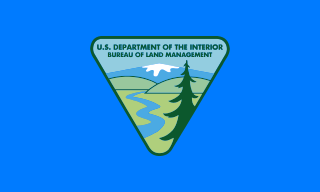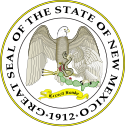
The Bureau of Land Management (BLM) is an agency within the United States Department of the Interior responsible for administering federal lands. Headquartered in Washington, D.C., and with oversight over 247.3 million acres (1,001,000 km2), it governs one eighth of the country's landmass.

The United States Department of the Interior (DOI) is an executive department of the U.S. federal government responsible for the management and conservation of most federal lands and natural resources. It also administers programs relating to Native Americans, Alaska Natives, Native Hawaiians, territorial affairs, and insular areas of the United States, as well as programs related to historic preservation. About 75% of federal public land is managed by the department, with most of the remainder managed by the Department of Agriculture's Forest Service. The department was created on March 3, 1849. It is headquartered at the Main Interior Building, located at 1849 C Street NW in Washington, D.C.

Mine reclamation is the process of modifying land that has been mined to ecologically functional or economically usable state. Although the process of mine reclamation occurs once mining is completed, the planning of mine reclamation activities occurs prior to a mine being permitted or started. Mine reclamation creates useful landscapes that meet a variety of goals ranging from the restoration of productive ecosystems to the creation of industrial and municipal resources. In the United States, mine reclamation is a regular part of modern mining practices. Modern mine reclamation reduces the environmental effects of mining.

The Surface Mining Control and Reclamation Act of 1978 (SMCRA) is the primary federal law that regulates the environmental effects of coal mining in the United States.

The Office of Surface Mining Reclamation and Enforcement (OSMRE) is a branch of the United States Department of the Interior. It is the federal agency entrusted with the implementation and enforcement of the Surface Mining Control and Reclamation Act of 1977 (SMCRA), which attached a per-ton fee to all extracted coal in order to fund an interest-accruing trust to be used for reclamation of abandoned mine lands, as well as established a set environmental standards that mines must follow while operating, and achieve when reclaiming mined land, in order to minimize environmental impact. OSMRE has fewer than 500 employees, who work in either the national office in Washington, DC, or of the many regional and field offices.
The California Department of Conservation is a department within the government of California, belonging to the California Natural Resources Agency. With a team of scientists, engineers, environmental experts, and other specialists, the Department of Conservation administers a variety of programs vital to California's public safety, environment and economy. The department's mission is to manage California's working lands. It regulates oil, natural gas and geothermal wells; studies and maps earthquakes and other geologic phenomena; maps and classifies areas containing mineral deposits; ensures reclamation of land used for mining; and administers agricultural and open-space land conservation programs. A division within the department dedicated to encouraging beverage container recycling has been moved into the newly created Department of Resources Recovery and Recycling (CalRecycle). Despite the similar name, the Department of Conservation should not be confused with the California Conservation Corps, another department within the Natural Resources Agency, which provides work experience for young adults. The Department of Conservation often collaborates with its federal equivalents, such as the U.S. Geological Survey.

The Oregon Department of Geology and Mineral Industries (DOGAMI) is the agency of the government of the U.S. state of Oregon responsible for collecting, maintaining and disseminating geologic information, and regulation of industries which commercially develop the state's geological resources, including Natural gas, Crude oil, and other Mineral exploration and Mining.
The Pennsylvania Department of Environmental Protection (DEP) is the agency in the U.S. state of Pennsylvania responsible for protecting and preserving the land, air, water, and public health through enforcement of the state's environmental laws. It was created by Act 18 of 1995, which split the Department of Environmental Resources into the Department of Environmental Protection and the Department of Conservation and Natural Resources. Its current secretary is Jess Shirley.
The United States House Natural Resources Subcommittee on Energy and Mineral Resources is one of the five subcommittees within the House Natural Resources Committee

An abandoned mine refers to a former mining or quarrying operation that is no longer in use and has no responsible entity to finance the cost of remediation and/or restoration of the mine feature or site. Such mines are typically left unattended and may pose safety hazards or cause environmental damage without proper maintenance. The term incorporates all types of old mines, including underground shaft mines and drift mines, and surface mines, including quarries and placer mining. Typically, the cost of addressing the mine's hazards is borne by the public/taxpayers/the government.

The Florida Department of Environmental Protection (FDEP) is the Florida government agency responsible for environmental protection.

The New Mexico Environment Department (NMED) is a state government agency responsible for "protecting and restoring the environment of the state of New Mexico to foster a healthy and prosperous New Mexico for present and future generations," according to its mission statement. This organization believes that New Mexicans must have fair treatment and meaningful opportunities for involvement in the development, implementation and enforcement in several laws. These include but are not limited to environmental laws and regulations regardless of race, creed, color, national origin, gender, disability, religious or political affiliation, income or educational level. This department is also commitment to equity in the communities they serve guided by the non-discrimination and environmental justice programs. It was established in the Department of the Environment Act (40th Legislature), enacted July 1, 1991, and is a cabinet-level department to oversee the state's environmental laws. Before its creation, these environmental duties were shared by the New Mexico Health Department’s Environmental Protection Division and other government agencies. The department has around 650 employees, and covers such areas as environmental health and protection, air quality, occupational health and safety, radiation control, water management and petroleum storage tank management. New Mexico is committed to the protection of public health.

The Oklahoma Department of Mines (ODOM) is a department of the government of Oklahoma responsible for overseeing and regulating all surface and sub-surface mining activities in the State. The Department is also responsible for the reclamation of land disturbed by mining operations. The Department regulates the production of coal and non-fuel minerals in the State.

Susan Elizabeth "Liz" Birnbaum served as Director of the Minerals Management Service in the United States from July 15, 2009, to May 27, 2010. Birnbaum was in charge of administering "programs that ensure the effective management of renewable energy [...] and traditional energy and mineral resources on the nation's Outer Continental Shelf, including the environmentally safe exploration, development, and production of oil and natural gas, as well as the collection and distribution of revenues for minerals developed on federal and American Indian lands."
The Kayenta mine was a surface coal mine operated by Peabody Western Coal Company, a subsidiary of Peabody Energy) on the Navajo Nation in northern Arizona from 1973 to 2019. About 400 acres were mined and reclaimed each year, providing about 8 million tons of coal annually to the Navajo Generating Station.
The Wyoming Department of Environmental Quality (DEQ) founded in 1973, is a Wyoming state agency to protect, conserve and enhance the environment of Wyoming "through a combination of monitoring, permitting, inspection, enforcement and restoration/remediation activities". It consists of 6 divisions and since 1992, the Environmental Quality Council (EQC), a separate operating agency of 7 governor-appointed members.

The Ministry of Energy and Mineral Resources of the Republic of Indonesia is an Indonesian ministry responsible for providing assistance to the President and Vice President in performing government's affairs in the field of energy and mineral resources. The current minister is Arifin Tasrif.
The Stream Protection Rule was a United States federal regulation issued by the Office of Surface Mining Reclamation and Enforcement that went into effect on January 19, 2017. These regulations implement Title V of the 1977 Surface Mining Control and Reclamation Act (SMCRA). The original regulations had been issued in 1979 and were updated in 1983. Litigation over mountaintop removal mining required changes to the regulations, which were issued in 2008. These regulations were in turn struck down by a judge after litigation by environmental groups. The new regulations, the Stream Protection Rule, were issued in January 2017.
The Montana Department of Natural Resources and Conservation (DNRC) is a government agency in the executive branch state of Montana in the United States with responsibility for ensuring sustainable development of the state's land, mineral, natural gas, oil, timber, water, and other resources.
The State of Nevada Commission on Mineral Resources, also known as the Nevada Division of Minerals, is a Nevada state agency division that focuses on regulating geothermal drilling activities in Nevada, whether conducted in private or public lands. The division is currently headed by a chairman, and the position is currently occupied by Josh Nordquist. It is headquartered in Carson City and maintains an additional office in Las Vegas.













